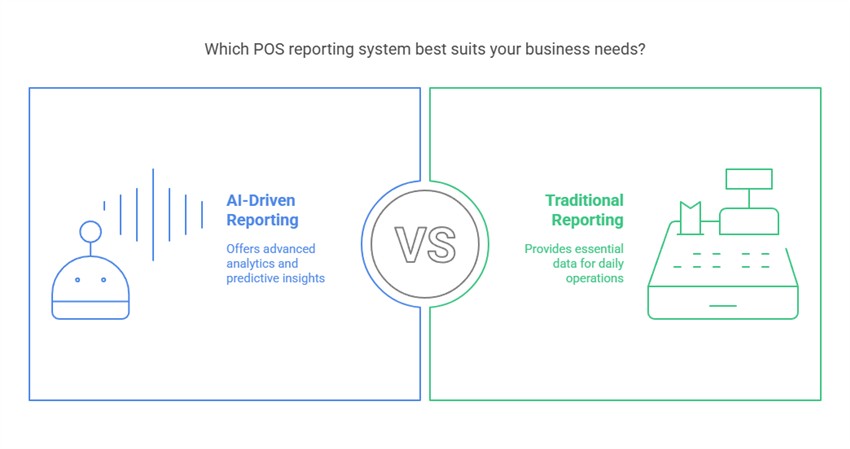
Today, AI-driven POS Systems are revolutionising the information flow to retailers. AI reporting offers advanced analytics and predictive insights compared to traditional POS system reporting. I love its ability to allow users to ask questions and research topics, enabling us to make more informed business decisions. Train your model with your information, and ask questions. If you do not understand something, you can ask for more information. It is brilliant. If anyone wants to attend a webinar on these functions, let me know.
While AI-powered analytics often deliver revolutionary insights, most users usually do not need them. Many retailers find that traditional POS reporting provides the information required for day-to-day business operations, which remains today's cornerstone of retail reporting.
The Trust Advantage of POS System Reporting
In business, POS systems have been refined over the decades, offering reporting functionality that captures actual transactions. Almost all errors have been worked out of the system, so retailers can confidently use this information to make business decisions.
The challenge with AI reporting systems lies in "hallucinations". These occur when the AI often generates plausible but factually incorrect information. Recent evaluations of advanced AI systems indicate hallucination rates of about 1.1% on simple tasks, and I have seen figures of 30-50% in complex tasks reported. What happens is that the AI, when asking your question, goes off track. It then moves along this track into nonsense. What is dangerous is that sometimes it appears plausible and can be hard to spot. It creates significant risks for retailers who might make substantial decisions based on inaccurate analysis. While doing a study, a pet shop retailer in Brisbane considered increasing its stock levels in dog toys based on an AI report trend. That trend did not exist. If they had followed it, they could have brought much excess inventory. Luckily, they picked it up. By contrast, when a POS system shows a 24-month history of a product sold, that figure represents a real figure.
Operational Speed and Accessibility
Timing becomes critical in retail environments where rapid decision-making directly affects sales outcomes. Our modern POS systems generate comprehensive reports within seconds for free. The system does not require an internet connection or an AI subscription.
Industry-Specific Relevance for Australian Retail
POS systems are designed specifically for retail operations. It incorporates Australian terminology and KPIs that align directly with Australian business practices. Standard POS reports include daily sales summaries, staff performance metrics, inventory turnover rates, and GST calculations, all of which conform to Australian requirements. An AI report, while powerful, often struggles with Australian-specific requirements. We have noticed that an AI analysis usually uses international accounting terminology that requires translation. When doing the report, we must do Google searches to determine what is being said. I have discussed this problem in depth here when we ran 100s of AI reports.
Security and Compliance for Australian Businesses
We have a big problem here, as much of the information in your POS System is restricted. For example, in Australia, we have strict privacy laws. Your POS systems incorporate security features specifically designed for this retail environment. These security measures have evolved over many years and are focused on retail-specific security requirements. Using AI for business reporting typically involves transmitting all your business data to third-party cloud services, raising concerns regarding data storage locations, retention policies, and potential use of proprietary business information. More dangerous is that all your information can be accessed by people in your organisation. Its hard to restrict parts of your payroll information so some of your staff might get what others earn.
Transparency in Reporting Methodology
When a POS system identifies top-selling products, the calculation methods are transparent and verifiable. You can do the calculation manually to figure out how it works. If the results appear unusual, you can easily check the report. This transparency builds confidence in the process.
AI-generated reports generally suffer from what we call "the black box problem." We get a result, but no one knows the reasoning behind its recommendations, making it difficult for anyone to understand the findings.
Consistent Reporting Over Time
POS reporting remains consistent over time. Once a retailer masters it, they know how to use it, what it gives them, and how to make meaningful comparisons over time.
AI systems face challenges with what we call "model drift." When you do the same thing, use the same prompts, you probably get different responses, each run of a report gives a different answer.Each run is an experiment.
When to Use Each Reporting Type
The clear advantages of traditional POS reporting for day-to-day retail operations, POS reporting excels in managing daily operations, staff performance evaluation, inventory control, cash flow monitoring, tax compliance, and comparative performance analysis. These functions form the operational backbone of Australian retail businesses.
I like to think of AI reporting as going to see an expert. They often have great knowledge in a particular area of your business and can help you examine the situation. They can tell you about subtle patterns in the industry and what is likely to happen, giving you insights, but you need to be very careful about accepting their advice without further thought. What we love is its ability to allow you to ask questions and explore.
Implementation Recommendations for Australian Retailers
For Australian retailers considering their reporting, you need a robust POS System that provides the fundamental business metrics.
When evaluating AI tools, take their advice with a grain of salt. We expect that in ten years, AI reporting will take over, but not yet. We are all experimenting with it. Its a lot of fun but think of it as science experiment.
Written by:

Bernard Zimmermann is the founding director at POS Solutions, a leading point-of-sale system company with 45 years of industry experience. He consults to various organisations, from small businesses to large retailers and government institutions. Bernard is passionate about helping companies optimise their operations through innovative POS technology and enabling seamless customer experiences through effective software solutions.



